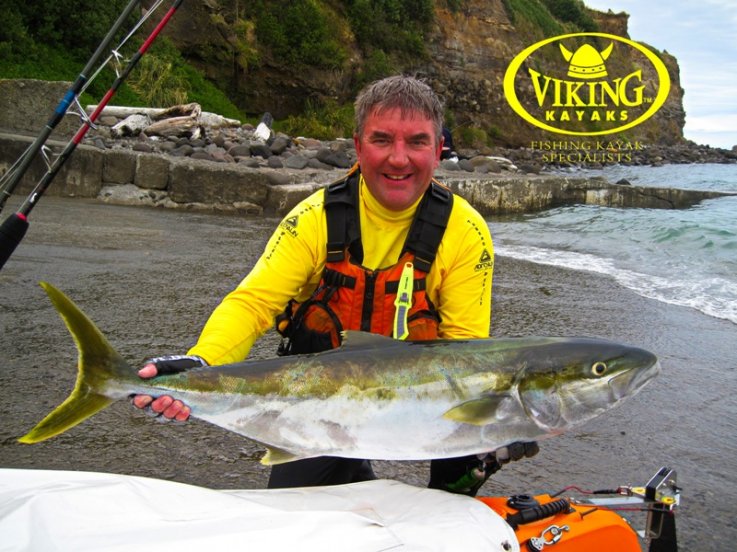Kayak fishing light tackle - setting up to go light
2:12PM 10th Feb 15

Kingfish of any size can be a handful, but even a modest fish such as this light tackle specimen captured in just a few meters of water behind the breakers will stick in your mind for a long time.
One of the real joys of fishing from kayaks is the ease with which we end up on a “Nantucket sleigh ride”. Even a modest sized fish can have us moving against the wind, while larger fish can end up totally relocating us before the battle is done. This adds a dimension not experienced in larger craft as not only do we need to watch for the likes of cray pot markers, we need to make sure we aren’t being dragged into danger such as reef breaks. In the extreme when targeting larger pelagics and game fish we need to pay close attention to not being dragged too far from home!
That sense of trepidation when everything is pushed to the absolute max and the kayak is being dragged sideways by a big fish on light gear - even if you don’t win them all this is the stuff dreams are made of!
One aspect of this that’s always appealed is how our mobility across the water enables us to successfully fish light tackle. In this context I’m not necessarily talking about light line classes below an arbitrary point, but about light-for-species line classes e.g. 1 – 4kg for fish like snapper and trevally, or 6 – 15kg for the likes of kingfish and hapuku. 15kg might not sound like light tackle to many anglers, but when hooked to 30kg of rampaging kingfish it can seem like gossamer cobweb as you struggle to keep the fish from amongst the stones.
In these situations an un-anchored kayak’s mobility works to our advantage in three ways:
- Reduced drift pressure – since there’s only a small hull in the water and the overall weight of angler and graft is tiny compared to fishing from bigger boats, the kayak quickly moves to follow the fish. In turn this works effectively with factors such as line stretch, rod flex, and the reel’s drag to greatly reduce stresses on fishing lines. The result is that we have the ability to push lines harder (fish heavier drags) compared to fishing from bigger boats.
- Reduced line pressure – since the kayak tracks after a fish without the need to be driven to give chase we usually end up with considerably less line in the water. The lack of “belly” in the line keeps us in more direct contact with our quarry, and again allows us to fish heavier drag settings for a greater level of control.
- Ability to stay on top of the fish – as the kayak tracks along in response to line pressure we are often able to wind closer to the fish until we’re almost directly over top of it. This reduction in line angle is probably the most significant difference to larger craft when fishing light lines as it considerably reduces the risk of being reefed. This has been the secret to some of my most memorable successes such as a 16.5kg hapuku on 6kg line and a 15kg king on 8kg line from just 4m of water.
Of course all this assumes one thing: there’s not too much wind pushing us around. Wind is our single biggest nemesis, both as far as overall safety is concerned and with our ability to fight fish. With practice rough water isn’t too much of an issue in a kayak. In fact I find I’m often far more comfortable sitting in a low-slung kayak in sloppy and rough conditions than I am aboard bigger boats. In fact when fighting fish from kayaks I often use waves and swell to pump my fish for me – wind into the trough, hang on till the crest, then wind into the next trough.
The Profish GT in its element sneaking around the shallows and amongst the rocky gutters. This became so much fun it distracted me from the fishing!
Wind is a whole different animal though, and when it starts to blow I know I’m in for a hard day. There are plenty of spots around the country (especially in Northland and Coromandel) where it’s possible to fish in strong winds without associated chop, but the paddling is always going to require more effort and the fishy battles will be considerably tougher. In fact, regardless of expected sea conditions, if the forecast predicts winds of more than 10 knots I leave the light tackle behind and revert to more normal line classes.
Kahawai are a great place to start with light tackle, willing battlers and sometimes a handful at the side of the kayak, they will quickly test if you have everything sorted and where it needs to be.
What about a drogue?
When talking about wind the inevitable question is “what about using a drogue (sea anchor)?” In the context of fishing light line, having a drogue in the water effectively negates the advantages of fishing from kayaks and puts us back on a level playing field with larger craft. The resistance of the drogue that holds us against the wind also stops the kayak tracking after the fish. This results in more line in the water with lots more angle, hence no advantage when compared to fishing from a bigger boat.
Part two of the question then becomes “once hooked up can’t I lift the drogue from the water or release it under a float?” The difficulty in this situation is that we then end up with a two pronged battle. In the first instance we’re fighting the fish on the end of the line, but without the drogue we now also have to fight the wind. Even if initially it pushes us towards our quarry and we can quickly recover line we will usually end up blown past the fish. At this point the light tackle battle is usually lost unless the line is strong enough to skull-drag the fish through the water faster than the kayak is being blown along!
Is a rudder useful?
Regardless of line class, having a rudder can be very useful when playing any fish able to tow the kayak. Water flowing along the keel and over the rudder blade (a rudder isn’t of any assistance unless there’s water flowing over it) makes it possible to steer with your feet while using both hands for rod and reel. This allows us to have some control over the direction of the kayak to help avoid hazards and cray pots, and also allows us to run out to the side of the fish for a little side strain.
We are still at the mercy to the fish we’re hooked up to regarding overall direction, but I find the most useful advantage is it helps me keep the line over my preferred side of the kayak so I’m not so tempted to pass the line across the bow of the kayak. In turn this lessens the risk of having light lines rub the kayak. While not necessarily the major problem some might think (wet braid line on wet PE plastic is surprisingly forgiving) I want to minimise any risks to successfully landing the fish.
Having wickedly sharp hooks applies to all forms of light tackle fishing, including trolling lures. After every capture check the hooks and replace any that aren’t perfectly sharp, or retire the lure until it can be sorted later.
Tackle considerations
Fishing light lines from kayaks has similar tackle considerations to larger craft:
- Longer rods are more forgiving as they bend over a wider arc. This gives more time to respond to changes in line pressure, especially if the fish suddenly runs and we need to reduce drag.
- I much prefer smaller reels, especially the low profile bait casters. The lightweight spools and modest line capacities mean less inertia allowing the spool to accelerate quickly in response to sudden increases in pressure
- Having smooth reel and drag is critical to being able to apply maximum pressure without popping the line. While the kayak towing across the water helps, a jerky drag will inevitable mean lost fish.
- When fishing braid lines I like to use longer leaders. The extra stretch from the mono or fluorocarbon helps reduce shock loadings on knots and also means fewer pulled hooks on soft mouthed specie such as trevally.
- Always use “sticky” sharp hooks. Light lines mean reduced strike pressures to dive the hook home so it’s critical to have only the sharpest hooks.
Fishing light tackle from kayaks means we can track after fish with relative ease. In turn this makes large line capacities unnecessary and we can successfully fish delightfully small reels.
Do you have a strategy for landing the fish?
Something many of us forget until the last minute, have your landing strategy sorted. Before you even put a bait or lure in the water get your glove, gaff, net, or fish grippers in place and ready to go. I’ve done it myself and seen plenty of others go through the same panic, you have a big fish nearing the side of the kayak and there’s the sudden realisation the necessary tools are still safely stowed. It’s then a mad scramble to dig whatever is needed from under covers or inside hatches with one hand while trying to keep pressure on the fish with the other. Often we get away with it, but when fishing light tackle there isn’t any margin for error.
A quick set up with the barest minimum of gear and ready to launch, time to put the new Profish GT through its paces on a misty summer afternoon
Glorious Distractions
Twelve knots of breeze and a light misting rain was just perfect to take the direct sun off the water, time for a sneaky light tackle session around the rocks. Even better, I finally get a chance to blood the new Profish GT in one of the environments it was designed for.
The Profish GT in its element sneaking around the shallows and amongst the rocky gutters. This became so much fun it distracted me from the fishing!
More distractions – blue mackerel happily scoffed anything I put in the water, including this big 6-inch grub. Great fun on really light gear it took conscious effort to avoid them and target the pannies lurking below...
This article was written by Stephen for the NZ Fishing News magazine, read more of Stephens Fishing News articles HERE
For all the latest news and updates follow us on








